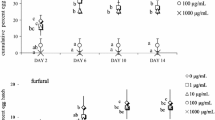Abstract
The Columbia root-knot nematode (CRKN), Meloidogyne chitwoodi, is an EPPO A2 type quarantine pest since 1998. This nematode causes severe damage in economically important crops such as potato and tomato, making agricultural products unacceptable for the fresh market and food processing. Commonly used nematicidal synthetic chemicals are often environmentally unsafe. Essential oils (EOs) may constitute safer alternatives against RKN. EOs, isolated from 56 plant samples, were tested against CRKN hatching, in direct contact bioassays. Some of the most successful EOs were fractionated and the hydrocarbon molecules (HM) and oxygen-containing molecules (OCM) fractions tested separately. 24 EOs displayed very strong hatching inhibitions (≥90 %) at 2 µL mL−1 and were further tested at lower concentrations. Dysphania ambrosioides, Filipendula ulmaria, Ruta graveolens, Satureja montana and Thymbra capitata EOs revealed the lowest EC50 values (<0.15 µL mL−1). The main compounds of these EOs, namely 2-undecanone, ascaridol, carvacrol, isoascaridol, methyl salicylate, p-cymene and/or γ-terpinene, were putatively considered responsible for CRKN hatching inhibition. S. montana and T. capitata OCM fractions showed hatching inhibitions higher than HM fractions. The comparison of EO and corresponding fractions EC50 values suggests interactions between OCM and HM fractions against CRKN hatching. These species EOs showed to be potential environmentally friendly CRKN hatching inhibitors; nonetheless, bioactivity should be considered globally, since its HM and OCM fractions may contribute, diversely, to the full anti-hatching activity.

Similar content being viewed by others
References
Abbott WS (1925) A method of computing the effectiveness of an insecticide. J Econ Entomol 18:265–267
Abd-Elgawad M, Omer EA (1995) Effect of essential oils of some medicinal plants on phytonematodes. Anz. Schadlingsk. Pfl. 68:82–84
Andrés MF, Gonzáles-Coloma A, Sanz J, Burillo J, Sainz P (2012) Nematicidal activity of essential oils: a review. Phytochem Rev 11:371–390
Bai CQ, Liu ZL, Liu QZ (2011) Nematicidal constituents from the essential oil of Chenopodium ambrosioides aerial parts. E-J Chem 8:S143–S148
Barbosa P, Lima AS, Vieira P, Dias LS, Tinoco MT, Barroso JG, Pedro LG, Figueiredo AC, Mota M (2010) Nematicidal activity of essential oils and volatiles derived from Portuguese aromatic flora against the pinewood nematode, Bursaphelenchus xylophilus. J Nematol 42:8–16
Barbosa P, Faria JMS, Mendes MD, Dias LS, Tinoco MT, Barroso JG, Pedro LG, Figueiredo AC, Mota M (2012) Bioassays against pinewood nematode: assessment of a suitable dilution agent and screening for bioactive essential oils. Molecules 17:12312–12329
Batish DR, Singh HP, Kohli RK, Kaur S (2008) Eucalyptus essential oil as a natural pesticide. For Ecol Manag 256:2166–2174
Conceição IL, Cunha MJM, Feio G, Correia M, Santos MCV, de Abrantes IMO, Santos MSNA (2009) Root-knot nematodes, Meloidogyne spp., on potato in Portugal. Nematology 11:311–313
Council of Europe (2010) European pharmacopoeia. European Directorate for the Quality of Medicines, Strasbourg, p 241
Dias MC, Conceição IL, de Abrantes IMO, Cunha MJ (2012) Solanum sisymbriifolium - a new approach for the management of plant-parasitic nematodes. Eur J Plant Pathol 133:171–179
Douda O, Zouhar M, Mazáková J, Nováková E, Pavela R (2010) Using plant essences as alternative mean for northern root-knot nematode (Meloidogyne hapla) management. J Pest Sci 83:217–221
Echeverrigaray S, Zacaria J, Beltrão R (2010) Nematicidal activity of monoterpenoids against the root-knot nematode Meloidogyne incognita. Phytopathology 100:199–203
EPPO (2012) Data sheets on quarantine pests: Meloidogyne chitwoodi. http://www.eppo.int/QUARANTINE/nematodes/Meloidogyne_chitwoodi/MELGCH_ds.pdf. Accessed 15 Jan 2014
FAO (2009) International year of the potato 2008, New light on a hidden treasure. Food and Agriculture Organization of the United Nations, Rome
Faria JMS, Barbosa P, Bennett RN, Mota M, Figueiredo AC (2013) Bioactivity against Bursaphelenchus xylophilus: nematotoxics from essential oils, essential oils fractions and decoction waters. Phytochemistry 94:220–228
Faria JMS, Sena I, Maleita CM, Vieira da Silva I, Ascensão L, Abrantes I, Bennett RN, Mota M, Figueiredo AC (2014) In vitro co-culture of Solanum tuberosum hairy roots with Meloidogyne chitwoodi: structure, growth and production of volatiles. Plant Cell Tissue Organ cult 118:519–530
Figueiredo AC, Barroso JG, Pedro LG, Scheffer JJC (2008) Factors affecting secondary metabolite production in plants: volatile components and essential oils. Flavour Frag. J. 23:213–226
Gokte N, Maheshwari ML, Mathur VK (1991) Nematicidal activity of few essential oils against root-knot and cyst nematode species. Indian J Nematol 21:123–127
Golden AM, O’Bannon JH, Santo GS, Finley AM (1980) Description and SEM observations of Meloidogyne chitwoodi n. sp. (Meloidogynidae), a root-knot nematode on potato in the Pacific Northwest. J Nematol 12:319–327
GraphPad Prism® version 5.00 for windows, graphpad software, San Diego California USA. www.graphpad.com. Accessed 18 Jan 2014
Gupta A, Sharma S, Naik SN (2011) Biopesticidal value of selected essential oils against pathogenic fungus, termites, and nematodes. Int Biodeterior Biodegradation 65:703–707
Hussey RS, Barker KR (1973) A comparison of methods of collection inocula of Meloidogyne spp., including a new technique. Plant Dis Rep 57:1025–1028
Ibrahim SK, Traboulsi AF, El-Haj S (2006) Effect of essential oils and plant extracts on hatching, migration and mortality of Meloidogyne incognita. Phytopatholog Mediterr 45:238–246
Kang JS, Moon YS, Lee SH, Park IK (2013) Inhibition of acetylcholinesterase and glutathione S-transferase of the pinewood nematode (Bursaphelenchus xylophilus) by aliphatic compounds. Pestic Biochem Phys 105:184–188
Kim J, Seo SM, Park IK (2011) Nematicidal activity of plant essential oils and components from Gaultheria fragrantissima and Zanthoxylum alatum against the pine wood nematode, Bursaphelenchus xylophilus. Nematology 13:87–93
Kong JO, Park IK, Choi KS, Shin SC, Ahn YJ (2007) Nematicidal and propagation activities of thyme red and white oil compounds toward Bursaphelenchus xylophilus (Nematoda: parasitaphelenchidae). J Nematol 39:237–242
Kumrungsee N, Pluempanupat W, Koul O, Bullangpoti V (2014) Toxicity of essential oil compounds against diamondback moth, Plutella xylostella, and their impact on detoxification enzyme activities. J Pest Sci 87:721–729
Leela NK, Khan RM, Reddy PP, Nidiry ESJ (1992) Nematicidal activity of essential oil of Pelargonium graveolens against the root-knot nematode Meloidogyne incognita. Nematol Mediterr 20:57–58
Loake G, Grant M (2007) Salicylic acid in plant defence—the players and protagonists. Curr Opin Plant Biol 10:466–472
Meyer SLF, Lakshman DK, Zasada IA, Vinyard BT, Chitwood DJ (2008) Dose-response effects of clove oil from Syzygium aromaticum on the root-knot nematode Meloidogyne incognita. Pest Manag Sci 64:223–229
Mitkowski NA, Abawi GS (2003) Root-knot nematodes. The Plant Health Instructor. doi:10.1094/PHI-I-2003-0917-01
Moharramipour S, Negahban M (2014) Plant essential oils and pest management. In: Sahayaraj K (ed) Basic and applied aspects of biopesticides. Springer, India, pp 129–153
Ntalli NG, Ferrari F, Giannakou I, Menkissoglu-Spiroudi U (2011a) Synergistic and antagonistic interactions of terpenes against Meloidogyne incognita and the nematicidal activity of essential oils from seven plants indigenous to Greece. Pest Manag Sci 67:341–351
Ntalli NG, Manconi F, Leonti M, Maxia A, Caboni P (2011b) Aliphatic ketones from Ruta chalepensis (Rutaceae) induce paralysis on root-knot nematodes. J Agr Food Chem 59:7098–7103
OEPP, EPPO (2009) Meloidogyne chitwoodi and Meloidogyne fallax. EPPO Bulletin 39:5–17
Oka Y, Nacar S, Putievsky E, Ravid U, Yaniv Z, Spiegel Y (2000) Nematicidal activity of essential oils and their components against the root-knot nematode. Phytopathology 90:710–715
Pérez MP, Navas-Cortés JA, Pascual-Villalobos MJ, Castillo P (2003) Nematicidal activity of essential oils and organic amendments from Asteraceae against root-knot nematodes. Plant Pathol 52:395–401
Pestana MH, Gageiro JN (2000) Análise de dados para ciências sociais. A complementaridade do SPSS. Edições Sílabo, Lisboa
Pinkerton JN, Santo GS, Ponti RP, Wilson JH (1986) Control of Meloidogyne chitwoodi in commercially grown Russet Burbank potatoes. Plant Dis 70:860–863
Rohlf JF (2000) NTSYS-pc, Numerical taxonomy and multivariate analysis system, version 2.1, user guide. Applied biostatistics, New York
Schenk UR, Hildebrandt AC (1972) Medium and techniques for induction and growth of monocotyledonous and dicotyledonous plant cell cultures. Can J Bot 50:199–204
Seefeldt SS, Jensen JE, Fuerst EP (1995) Log-logistic analysis of herbicide dose response relationships. Weed Technol 9:218–227
Wesemael WML, Viaene N, Moens M (2011) Root-knot nematodes (Meloidogyne spp.) in Europe. Nematology 13:3–16
Acknowledgments
The authors would like to thank Prof. Dr José Barroso, Prof. Dr Luis Pedro, Prof. Dr Graça Miguel, Prof. Dr Helena Trindade, Dr Diara Kady, M.Sc.’s Sofia Lima, Natacha Moura and Marta Taveira (Faculdade de Ciências da Universidade de Lisboa, CBV), Lic. Pedro Barbosa (Universidade de Évora), Dr Leandra Rodrigues (Instituto Superior de Agronomia, Universidade de Lisboa), Dr Marta Mendes (Faculdade de Ciências, Universidade de Lisboa), Prof. Dr Kiril Bahcevandziev (Escola Superior Agrária de Coimbra), Cacial – Cooperativa Agrícola de Citricultores do Algarve, C.R.L., and Eng. João Sanches (Mata Experimental do Escaroupim, Instituto da Conservação da Natureza e das Florestas), for providing some of the plant material and/or for the technical support. Jorge Faria is grateful to the Fundação para a Ciência e a Tecnologia (FCT) for the Ph.D. grant SFRH/BD/43 738/2008. This study was partially funded by FCT, under Pest–OE/EQB/LA0023/2011 and research contract PTDC/AGR-CFL/117026/2010.
Author information
Authors and Affiliations
Corresponding author
Additional information
Communicated by M.B. Isman
Electronic supplementary material
Below is the link to the electronic supplementary material.
Rights and permissions
About this article
Cite this article
Faria, J.M.S., Sena, I., Ribeiro, B. et al. First report on Meloidogyne chitwoodi hatching inhibition activity of essential oils and essential oils fractions. J Pest Sci 89, 207–217 (2016). https://doi.org/10.1007/s10340-015-0664-0
Received:
Revised:
Accepted:
Published:
Issue Date:
DOI: https://doi.org/10.1007/s10340-015-0664-0




